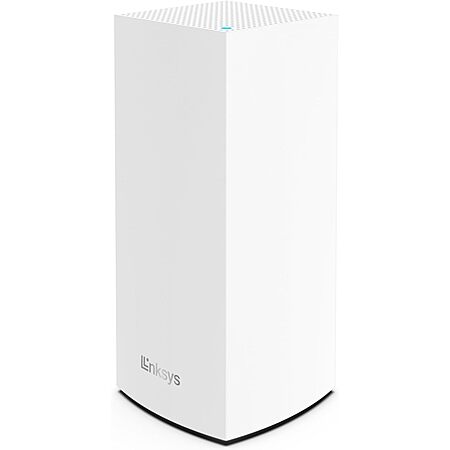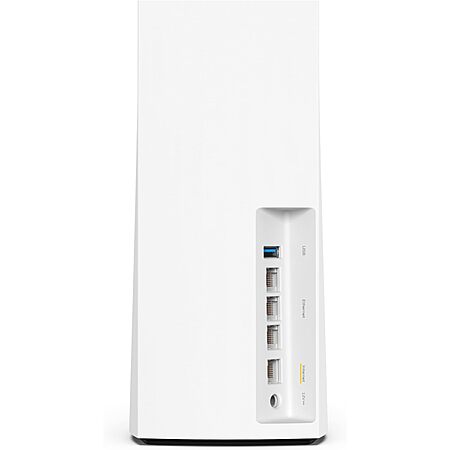Click here [dd-wrt.com] for a guide on installing DD-WRT
Download the latest DD-WRT builds from here [dd-wrt.com]
If you are not interested in using custom firmware yet, these routers support mesh with the stock firmware, but the USB port is disabled.
The stock firmware is relatively new, but is speculated to not receive many, if any, updates, so it may be best to wait until custom firmware support is merged and more mature before messing with installing custom firmware.
How to enable mesh:
- Setup your Main router completely.
- Plug your child node using the wan port to the main router lan port, wait for a solid purple light on the child node before proceeding.
- Log into your main router web admin.
- Click on CA at the bottom right.
- Click on Connectivity and CA Router setup.
- Click on both Add Wired and Add Wireless nodes buttons. Wait for the Add wireless button to re-enable.
- Click Done adding Child Nodes and then Apply.
- Now the child node light should start flashing purple and turn into a mesh mode when it turns blue.
- Disconnect Ethernet and wait for blue light again.
- Move node to desired location.
How to set up as access point:
- Disable DHCP (optional).
- Set the device to Bridge Mode under Connectivity tab.
- Connect cable from your router to a LAN port.
- Get some nail polish and a round sticker to cover the annoying flashing right light.
- Click the 'CA' at the bottom of the page to see the detailed configurations of wifi.
to unbrick and flash new firmware
run flashimg
run flashimg2
rename stock firmware to tortuga.img





Leave a Comment
Top Comments
Mind you that I only have 100Mbps Spectrum internet but I do stream/direct play 4k videos from a Plex media server to several Amazon Firestick 4k devices without issue. Overall IMO you would be hard pressed to find such relatively decent hardware for so cheap; especially a Mesh network.
It wasn't all smooth at first mind you. I kept getting disconnects; especially with the streaming IP cameras. But I discovered by disabling Express Forwarding all my streaming issues went away. (CA>Connectivity>Administration>Express Forwarding)
I'm guessing that Cisco's/Linksys' proprietary Express Forwarding routing protocol was causing havoc with the IP cams streaming capabilities. Also, disabling Node Steering seemed to make things more stable as well; mesh nodes no longer disconnect from the router when Node Steering is disabled. (CA>Wi-Fi Settings>Advanced>Node Steering)
Of course, user experience can vary so feel free to experiment. if the routers are giving you problems, try turning these features off and see if it works
It's not a deal if you never receive it.
1,239 Comments
Sign up for a Slickdeals account to remove this ad.
I have an Edgerouter X running with hardware offloading on a 1G line, and gets near 1G up and down (the ER-X cannot do up and down simultaneously at 1G), I have around 70 leases on the Er-X and around 30 static.
I am using 3 R7800 in AP mode over 2 stories and 4600 sqft and I have very good coverage, some slow spots, but manageable. I easily get 600+ Mbps down and 500+ Mbps up from the R7800 on wifi on the 160mhz ax211 devices. I plan to replace the R7800s with the LN1301 4-node mesh.
Testing speeds by connecting the one LN1031 I received to the existing LAN and connecting to its wifi (no other changes made) gets about 650 Mbps down, and 500 Mbps up on the same devices.
Before I take my whole network down, I am wondering:
1. Should I remove the Edgerouter X and use LN1301 as the main router to get full 1G duplex?
1a, Should I mod firmware to DD-WRT or OWRT with nss or keep stock?
1c. Should I keep the Edgerouter X and use LN1301 in stock bridge mode?
2. Is there any benefit to mesh nodes or should I mod the firmware and use these as additional APs?
Appreciate your thoughts based on your experience with the LN1301s.
I have an Edgerouter X running with hardware offloading on a 1G line, and gets near 1G up and down (the ER-X cannot do up and down simultaneously at 1G), I have around 70 leases on the Er-X and around 30 static.
I am using 3 R7800 in AP mode over 2 stories and 4600 sqft and I have very good coverage, some slow spots, but manageable. I easily get 600+ Mbps down and 500+ Mbps up from the R7800 on wifi on the 160mhz ax211 devices. I plan to replace the R7800s with the LN1301 4-node mesh.
Testing speeds by connecting the one LN1031 I received to the existing LAN and connecting to its wifi (no other changes made) gets about 650 Mbps down, and 500 Mbps up on the same devices.
Before I take my whole network down, I am wondering:
1. Should I remove the Edgerouter X and use LN1301 as the main router to get full 1G duplex?
1a, Should I mod firmware to DD-WRT or OWRT with nss or keep stock?
1c. Should I keep the Edgerouter X and use LN1301 in stock bridge mode?
2. Is there any benefit to mesh nodes or should I mod the firmware and use these as additional APs?
Appreciate your thoughts based on your experience with the LN1301s.
Our community has rated this post as helpful. If you agree, why not thank Guy767
Actually I would recommend at first using 2 Linksys LN1301s for a simple Bridge/AP + Mesh setup as it's relatively easy to configure and a good way to see if the LN1301s will work for you before using several LN1301s as a true Router+Mesh solution.
You need to change the Static IP address before switching to Bridge mode though. (CA>Connectivity>Internet Settings>Type of Internet Connection>Static IP Once that's done THEN switch to Bridge Mode)
For Bridge/AP Mode your Static IP address should look something like this... (Replace question marks with your relevant IP info)
Only by disabling Express Forwarding and Node Steering was I able to make my 4 LN1301s router+mesh setup work reliably. I'm thinking that each situation/network topology is unique though and that Express Forwarding or Node Steering can be left alone if everything is working for you.
Since I have 64 devices connected which sixteen 24/7 streaming 1080p IP cameras are a part of; disabling Express Forwarding and Node Steering made a huge difference/improvement. I went from a virtually unusable network with constant disconnects and streaming video frequently freezing to a rock solid/reliable LAN.
I like to reiterate that making sure you have no IP conflicts in your network is crucial as well. If you can; manually assign static IPs for all your devices in their network settings. You can check for IP conflicts in the LN1301's Troubleshooting section. (CA>Troubleshooting>Status)
If your devices have no innate way to assign static IPs then Manually Add Device Reservation in the LN1301's settings. (CA>Connectivity>Local Network>DHCP Reservations>Manually Add Device Reservation).
Sorry to be needlessly pedantic as you seem pretty knowledgeable when it comes to networking. But I would recommend before tinkering with Express Forwarding and Node Steering if you are having network reliability and streaming issues is to confirm first that there's no IP conflicts on your network. IP conflicts can be sneaky and insidious; especially when a large number of devices are connected and DHCP is enabled on your router.
Actually I would recommend at first using 2 Linksys LN1301s for a simple Bridge/AP + Mesh setup as it's relatively easy to configure and a good way to see if the LN1301s will work for you before using several LN1301s as a true Router+Mesh solution.
You need to change the Static IP address before switching to Bridge mode though. (CA>Connectivity>Internet Settings>Type of Internet Connection>Static IP Once that's done THEN switch to Bridge Mode)
For Bridge/AP Mode your Static IP address should look something like this... (Replace question marks with your relevant IP info)
In Bridge/AP + mesh mode I had 4 LN1301s working great without having to fiddle/tinker with Express Forwarding or Node Steering. Only when I tried switching to a true router+mesh setup did I encounter problems. (IP cams kept disconnecting and was unable to stream properly)
Only by disabling Express Forwarding and Node Steering was I able to make my 4 LN1301s router+mesh setup work reliably. I'm thinking that each situation/network topography is unique though and that Express Forwarding or Node Steering can be left alone if everything is working for you.
Since I have 64 devices connected which sixteen 24/7 streaming 1080p IP cameras are a part of; disabling Express Forwarding and Node Steering made a huge difference/improvement. I went from a virtually unusable network with constant disconnects and streaming video frequently freezing to a rock solid/reliable LAN.
I like to reiterate that making sure you have no IP conflicts in your network is crucial as well. If you can; manually assign static IPs for all your devices in their network settings. You can check for IP conflicts in the LN1301's Troubleshooting section. (CA>Troubleshooting>Status)
If your devices have no innate way to assign static IPs then Manually Add Device Reservation in the LN1301's settings. (CA>Connectivity>Local Network>DHCP Reservations>Manually Add Device Reservation).
Sorry to be needlessly pedantic as you seem pretty knowledgeable when it comes to networking. But I would recommend before tinkering with Express Forwarding and Node Steering if you are having network reliability and streaming issues is to confirm first that there's no IP conflicts on your network. IP conflicts can be sneaky and insidious; especially when a large number of devices are connected and DHCP is enabled on your router.
Use a openvpn cfg file for the server you want from the nord website. https://nordvpn.com/ovpn/
Sign up for a Slickdeals account to remove this ad.
In fact, I have enabled Express Forwarding on my Linksys MR9000 mesh mode (2 nodes) for over two years and I get almost full bandwidth on my 500 Mbps link, both upload and downloads and the uploads are consistently in the 510 Mbps range.
FWIW, I am super duper impressed with stock firmware on these Linksys units as they are much better than OpenWRT, imho.
PS: I have node steering + client steering enabled as well.
Thanks!
Is it possible to connect one Linksys router to Asus router as AP, and use other Linksys routers as Linksys mesh?
Sign up for a Slickdeals account to remove this ad.
Thanks!
Leave a Comment